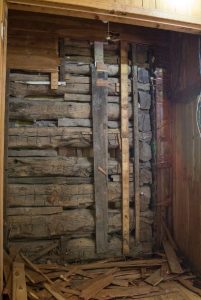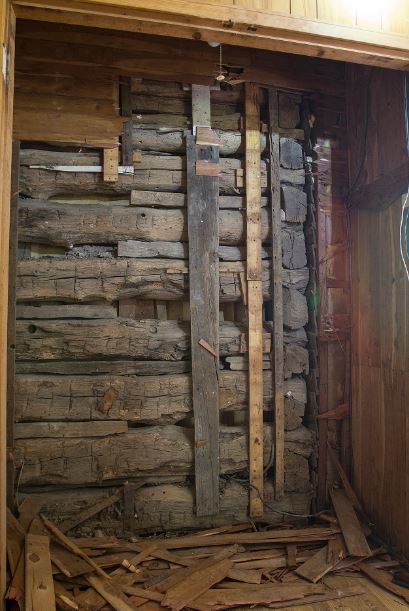
When local developer Curtis Grant peeled back layers of history on property he owns in Flower Mound, his first reaction was concern that his finding might derail plans for a residential project on the site.
For a man who makes his livelihood finding new uses for spaces, a log cabin filled with Texas history could put up legal barriers, stalling his Liberty Park development and possibly adding new levels of frustration.
“Yeah, but it’s really cool,” his wife said as she stared into the walls of a house on their property in west Flower Mound.
The 4.33-acre parcel of land at situated at the southeast corner of Quail Run and Flower Mound roads could eventually be home to 12 homes, as Grant intends. But it’s also “home” to a log cabin dating back to the 1860s. The cabin was discovered inside the walls of a house currently standing, facing Flower Mound Road.
Grant has had the property under contract since 2013 and the previous owner, who had been there since the 1970s, was allowed to stay in the house on one of the lots rent free. She moved out at the end of May, which is about the time Grant found logs inside the walls of her 4,500-square-foot Flower Mound farm house. The property was destined to be demolished when Grant’s discovered the log cabin.
He knew the former owner had found newspapers dated from 1903 in the walls of her house, but after research with Peggy Riddle of the Denton County Office of History and Culture and Flower Mound historian Mark Glover, the cabin’s true story was revealed.
“It’s a bittersweet situation,” said Grant, who has lived in the town for more than 20 years. “I’m very invested in the community.”
The three lots needed to keep the cabin where it is would cost a buyer between $400,000 and $500,000, Grant said, adding that he’s willing to work with the town to find a solution.
“I’m not a multi-millionaire. I can’t afford to just give the land.”
The property was part of a Republic of Texas Land Grant that was patented in 1854 by William Gibson. The original survey was for 360 acres and the cabin is a one room structure measuring approximately 16’ x 16’, which is the minimal size structure required to perfect the land grant.

William Gibson was the original owner of this property and is believed to have built this log cabin.
There were several William Gibsons in early Texas history. Glover said this William Gibson was here in 1844 as part of the Missouri Colony of Peters Colony.
As he learned more about Gibson and the historic value of the log cabin on his land, Grant decided he wanted to work with the Flower Mound Foundation to help preserve it in its original location. During their work, the Foundation was told that the Town of Flower Mound wanted to buy the cabin and keep it where it is.
But earlier this week, Grant received a call from Town Manager Jimmy Stathatos, who told him the town council had decided not to go ahead with the purchase because it was too expensive. Three lots would have to be purchased to keep the cabin where it is. Instead, the town decided that moving the cabin to another location would be fine.
Mayor Tom Hayden said there was never a hard-and-fast deal made for the town to buy these lots, but that Grant has been very helpful trying to find the best way to make it work.
“Our first preference is to leave the cabin where it is,” Hayden said. “If we can do that and remain responsible in a fiduciary way, that’s what we want to do. If it cannot be done that way, we’ll have to look at other alternatives.”
Hayden also said the council did not make any decisions about the cabin purchase, but directed Stathatos to look at the situation and make a recommendation to the council. That has yet to come, Hayden said.
His understanding is that the land would cost about $750,000.
“We don’t have that kind of commitment to do that,” he said. “We would help but we’re dealing with taxpayer money and we can’t just say, ‘We’re going to do this.'”
Nevertheless, Grant and the Foundation are convinced the cabin should stay where it is to preserve its legacy.
Glover and Grant indicated they will meet again next week to discuss how the town may be involved with saving this cabin at its original site. “Everyone is working hard to preserve this cabin at its original location,” said Glover.
Land rich
Glover said that Texas was land rich and people poor when she won her independence from Mexico in 1836. The new Texas government enticed settlers to the wilds of Texas with free land. A family could receive 640 acres, if they built a 16’ x 16’ log cabin. Single men got 320 acres.
But North Texas had Indian problems, and the one thing settlers like more than free land was their scalp. Sam Houston took it on himself to calm the Indian problems in North Texas and clear the path for new settlement.
Houston sent out messengers to gather the warring Indian chiefs of the nine tribes in North Texas. Houston’s goal was to create peace through signing a treaty at Bird’s Fort, six miles south of present Flower Mound. Houston spent a month camping on the prairies around Bird’s Fort, waiting for the chiefs to be assembled. He likely saw the actual flower mound and perhaps used it as a lookout for the Indian chiefs.
Houston grew weary of waiting for and returned to Austin after a month. But the Treaty of Bird’s Fort was agreed to by the nine tribes in 1843 and ratified by the Republic in early 1844, clearing the way for the settlement of North Texas.
The Republic of Texas contracted with empresarios to bring new settlers to Texas. Peters Colony was one of these contracts and offered land grants to bring settlers to North Texas. The Missouri Colony of Peters Colony settled much of Flower Mound and Northern Tarrant County.
In May of 1844, sixteen families from Platte County Missouri loaded their wagons to brave their move to the wilds of North Texas. Most were related in some way. William Gibson, who made the trip back to Texas with them.
The journey was not easy. Swollen rivers and hostile Indians plagued the journey. The settlers had to camp for three weeks waiting to cross the Trinity River.
The last leg was among the hardest. Moving wagons through the virgin Cross Timbers was difficult. It was full of post oaks, blackjacks, and thick underbrush. Some called it the Cast Iron Forest because it was so difficult to cut through. The Missouri Colonists were among the first white settlers to carve a trail into what is now Flower Mound.
After days of hacking through the forest, the Missouri Colony emerged on some small prairies. The first was in Northern Flower Mound, known as Holsford’s Prairie now (named for Holford family who were also Peters Colonists). The second prairie they emerged on was Long Prairie.
Long Prairie was a welcome site for the weary travelers. Long Prairie was about four miles long and one mile wide. Toward the east end was a mound that rose 50 feet above the surrounding area. It was later dubbed “The Flower Mound.”
From the raised area, settlers could survey not only their past travels, but their future ahead. Many made their new homes on Long Prairie, not far from the Flower Mound, according to Glover.
It was on the southwestern end of Long Prairie that Gibson built this one room log cabin in 1860, nestled near a corner of the Cross Timbers. Denton Creek was not far south, and Gibson’s Church, Lonesome Dove Baptist Church, was just across the creek.
But what is that history worth in today’s economy?
Grant has not yet looked at what the cabin might be worth monetarily, but he said the chapter of time it encapsulates is forever gone.
“But this type of history, it will never get played out again,” he said. “The chance of it happening again, it’s just not going to happen.”
What happens in Flower Mound …
Glover, who is a part of the Flower Mound Foundation, said Flower Mound’s history with preserving history is not good.
“I remember Edward Marcus’s Lodge home and when it was torn down,” he said. “It was a beautiful wood-framed lodge designed by famed architect O’Neal Ford. The birth of Flower Mound was planned in the Marcus lodge. Early leaders met here, both before and after the town was formed. It was really our first town hall. Some of us tried to save it, but there was no money available.”
Glover continued.
“Then there was the Black Mark Farm Showbarn, also designed by O’Neal Ford. They tore it down and someone stole Bob Rheudasil’s Surrey out of it when he was in a coma in the hospital, after his life threatening brain stem aneurism.
“Some talk about the old stone house on Wichita Trail, and how the town did not have enough money to save it. This was the oldest home in Flower Mound, supposedly. That is until we found this log cabin of 1860s vintage. The stone from this old house was saved and is laying on the ground at the sewer plant. This is how we have invested in and treated our history.”
Research shows that Gibson started Lonesome Dove Baptist Church in 1846 and moved it to Denton Creek in 1847.
“Clearly, this was not the first cabin William Gibson built in North Texas, but it may have been the last,” Glover said. “He died in 1865, just five years after this cabin was built.
Records show that the William Ward Kerr family lived in this cabin in the 1890s. According to a Kerr descendant, Lee Olin Kerr was born in a log cabin set among the trees on the west side of George McCombs farm, about three mile west of the Flower Mound Church.
“They led hard, but amazing lives,” Glover said. “This cabin is a gift to remember them, but this gift requires investment from us.”
Heritage in a home
There is an old barn the county’s historical commission saved, which could be added to the cabin site, Glover said. It was dismantled from its Dixon Lane location. Glover suggested the cabin site could turn into a historic homestead.
“Maybe we could plant some of the crops our early settlers grew and furnish the cabin and barn with vintage furnishings and farm implements of the period,” he said. “It would be a special place for our children, and their children, to understand their heritage and the hardships of our early settlers.
“Some say we should tear this cabin down and doze these trees. Then pile up the old logs from the cabin on a concrete slab a few miles to the east and call this our history and heritage. This would be cheaper. To many of us, it would also be tragic.
“It will take significant sums of money and considerable work by many to save the cabin at this original location. But, we must try. We have lost too much already and will never have the chance to save this treasure again.”
As for Grant, he said even if the town doesn’t purchase his land, he would still intend to donate the cabin. There is a chance, however, that he might sell it to help offset having to do additional work on the infrastructure of the land where the cabin stands. He already has contracts underway for that type of work on the remaining 9 lots.
He has told the town and the Foundation that he will push the sale of these three lots until the last possible time. That gives 12-18 months for the funds to be gathered.
“I think it’s a fantastic treasure … I feel like a steward of this. For whatever reason God put me here as a steward of it.”
See the cabin
Vaquero Development and The Flower Mound Foundation will host an Open House this Saturday, August 15th, from 10 a.m. to 12 p.m. to share the cabin with the community.
The Long Prairie Cabin is located at 4801 Quail Run in Flower Mound.
“Come by to see the cabin and the historic oaks surrounding it, take pictures, buy t-shirts, make donations, and volunteer. Please, wear closed toe shoes,” said Glover. Parking is across the street at Liberty Elementary.





















